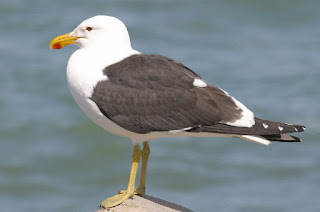Hautlaub GullSeagulls’
are a common sight around the world, and are seen especially along coastal
areas and inland waters. These birds are characteristic and social birds that
provide a great deal of enjoyment for viewers. The two most common seagulls
found in the deep south of Cape Town, are Kelp Gulls and Hautlaub Gulls.
 |
| Haurlaub's gull in flight. |
Kelp
gulls are broken up into five subspecies, of which the gull found in South
Africa is referred to as the Cape gull. The upperparts and wings of a Kelp gull
are black while its’ head, belly, tail and very tip of wings, known as mirrors,
are white. The bill is coloured yellow with a distinctive red dot, and their
legs a tinged green-yellow that becomes a brighter yellow during the breeding
season. The Cape gull has a shorter bill and more pointed head than other
subspecies.
Hautlaub’s
gulls are smaller than Kelp gulls with black reddish feet and beaks of the same
colour. A mainly white gull with a grey back and upper wings, their wingtips
are black and their ‘mirrors’ white. During the breeding season their hood
becomes a faint lavender colour but during the rest of the year their heads
remain white.
They
are able to sit on ledges without being blown off from the Cape Town wind, due
to a small claw that is located halfway up their lower leg. Most birds are seen standing on one leg and
this is to warm up, this is done by conserving warmth in the body and reducing
heat lost through its legs.
 |
| Kelp gull. Notice the red dot on beak. |
Habitat
Kelp
gulls breed and live on coasts and islands throughout much of the southern
hemisphere. Although most subspecies remain in their homeland, some southern
populations migrate further north during the non-breeding season.
Hautlaub’s
gulls are native and non-migratory seagulls seen along the South African and
Namibian Atlantic Ocean coastline. Both species are rarely seen far from land
preferring inland islands and coastal areas such as harbours, bays, estuaries,
beaches and rocky shores.
When
in the air, seagulls in a group are known as a flight and when on the ground
are known as a colony. These seagulls, at times, journey inland to visit lakes,
rivers, reservoirs and grasslands as well as cities and towns.
 |
| Hautlaub's gull. |
Diet
Seagulls
are well known scavengers and omnivores and eat a variety of food, from worms,
insects and small fish to human refuse and chips. Both Kelp gulls and
Hautlaub’s gulls have adapted bills that aid in hunting for marine animals such
as fish, crab and shrimps. Kelp gulls can be seen picking up shellfish, flying
into the air and then dropping them onto the rocks below in the hope of
breaking them open.
Seagulls
are equipped to drink both fresh and salt water due to a pair of glands located
above their eyes, designed to flush out salt from their systems through
openings in their bills.
Behaviour
These
birds are able to learn and remember behaviours that are passed onto other
seagulls such as the stamping of their feet to sound as though it’s raining,
which tricks worms to surface. Seagulls can be aggressive birds and are usually
vocal, noisy and do not shy away from humans.
Reproduction
Both
species of seagulls’ form life-long monogamous pairs and breed between January
and October, with breeding peaking from February till April. A shallow and
large nest is built on the ground or in rocks, lined with feathers, leaves and
plant matter to make it warm and comfy. The female gull usually lays between 1
to 3 eggs, and both parents take it in turns to incubate their eggs.
 |
| A pair of Kelp gulls. |
Seagulls
are attention, protective and devoted parents to their offspring. Both parents
are responsible for feeding their chicks, by regurgitation, until they are
ready to fledge. Until the new-born gull is able to fly and almost fully grown,
it does not leave the safety of the best. Young seagulls live together in
nursery schools and learn behaviours from one another in order to survive and
fend for themselves in adulthood.
Did
you know?
Seagulls
have 4 cones in their eyes, humans have just 3, and it is the fourth cone that
gives them the ability to see infra-red colour.

No comments :
Post a Comment